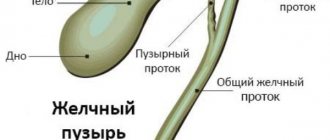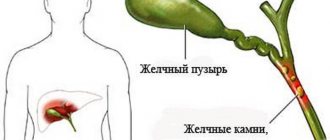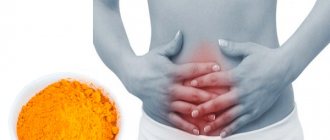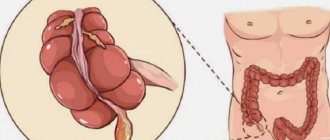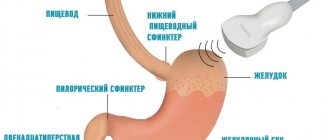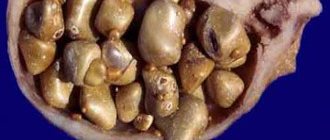Chronic or acute cholecystitis with the presence of stones in the gallbladder is called calculous. Concretions - stones of any size are formed in varying quantities in the lumen of the bladder or ducts.
With this inflammatory disease, there is a feeling of heaviness and pain in the right hypochondrium. Also characteristic symptoms for it are nausea and bitterness in the mouth.
When stones move to the area of the bladder neck and common bile duct, the patient develops jaundice and attacks of biliary colic begin.
To diagnose calculous cholecystitis, radionuclide, x-ray, and ultrasound methods of examining the gallbladder are used. Calculous cholecystitis is treated with surgery in the form of cholecystectomy and litholytic therapy. This disease has a long course and always progresses, combining periods of exacerbation and quiescence.
What it is?
One of the manifestations of cholelithiasis is calculous cholecystitis. Along with signs of inflammation of the gallbladder, this disease may cause the appearance of gallstones - stones in the lumen of the gallbladder or in the bile duct.
In the latter case, the outflow of bile is hampered or completely blocked, which results in attacks of biliary colic.
Forms and types
Calculous cholecystitis can occur in acute and chronic form with a complicated or uncomplicated course. Forms of calculous cholecystitis:
- phlegmonous;
- catarrhal;
- purulent;
- gangrenous.
According to the course, atypical, cardialgic, intestinal, typical, esophagalgic calculous cholecystitis are distinguished. Complications of the disease may include biliary pancreatitis, septicopyemia, gallbladder cancer, obstructive jaundice, and purulent cholangitis.
Stages of development
Calculous cholecystitis develops in 4 stages. At the initial stage of the disease, thick bile, microliths in the gallbladder, and bile stasis appear. In the second stage, stones form in the gallbladder. The third stage is characteristic of chronic calculous cholecystitis, and at the fourth stage all possible complications arise. Gallstones in the gallbladder can have different sizes and shapes: multifaceted, branched, round, ovoid.
Calculous cholecystitis in acute form develops after long-term asymptomatic cholelithiasis. As a result of blockage of the common bile duct by a stone, inflammation of the bladder wall begins. Pus accumulates inside the bladder and bile peritonitis forms. Inflammation in the gallbladder develops more slowly in the chronic form of the disease. In this case, it is not infectious in nature.
Prevalence and significance
Approximately 10% of the adult population has calculous cholecystitis. In women it occurs 5 times more often than in men. This disease is usually diagnosed in people over 40 years of age. But sometimes it is detected in childhood.
Risk factors:
- chronic gastritis;
- pancreatitis;
- biliary dyskinesia;
- helminthiases;
- cirrhosis of the liver;
- duodenitis;
- diet high in animal fats;
- long-term use of hormonal contraceptives;
- heredity;
- restriction of motor mode;
- irregular meals;
- injuries of the bladder and ducts.
Acute and chronic calculous cholecystitis
The article was prepared by a specialist for informational purposes only. We urge you not to self-medicate. When the first symptoms appear, consult a doctor.
Description of the disease
Content:
Calculous cholecystitis is a special form of cholecystitis, which is characterized by the presence of stones (calculi) in the gall bladder. The disease is one of the manifestations of cholelithiasis.
Calculous cholecystitis is characterized by inflammation of the gallbladder and the presence of stones in it. Stones generally have a mixed composition (lime-pigment-cholesterol), homogeneous bilirubin (pigment) or cholesterol are less common. The size of the stones can reach the size of a chicken egg, and the number varies from a few to hundreds, the shape is different.
They can be located in the cavity of the gallbladder, which is observed in 75% of cases, and support with their presence a weak inflammatory process, leading to fibrosis, as well as the deposition of calcium salts (calcification). But if stones end up in the bile duct, they can impede or block the outflow of bile and cause acute inflammation, characterized by attacks of biliary colic.
The prevalence of the disease is quite high, reaching 10% of the entire adult population, most often people who have crossed the 40-year mark are affected, but there are cases when calculous cholecystitis was diagnosed in children. Women are several times more likely to suffer from this disease, which is explained by the specifics of their hormonal levels.
The following population groups are at risk of developing the disease:
- women and especially pregnant women;
- people who are obese or who have dramatically lost weight;
- representatives of Scandinavian and Indian peoples, their level of this disease is much higher than that of others;
- older people;
- those who take medications and contraceptives that affect hormonal levels.
Factors leading to the formation of gallstones and the development of calculous cholecystitis:
- dyscholia (change in bile composition);
- cholestasis (stagnation of bile);
- inflammatory component, in this case primary cholecystitis.
In a healthy body, components of bile such as pigments, minerals, bile acids, and lipids are in a colloidal state. But when the ratio between the concentration of cholesterol and bile acids changes, the former precipitates and subsequently crystallizes. This situation can be provoked by poor nutrition, diabetes, hepatitis, obesity, and infectious diseases.
Dyscholia contributes to the thickening of bile and its stagnation, which leads to various types of infection of the gallbladder with pathogens such as bacteroides, E. coli and others. The infection causes inflammatory changes in the walls of the gallbladder.
Fasting or overeating, high levels of animal fat in the diet, physical inactivity, heredity and long-term use of hormonal contraception can increase the lithogenicity (ability to form stones) of bile.
Calculous cholecystitis is often preceded by ordinary, acalculous cholecystitis, which leads to disruption of the dynamics of gallbladder emptying.
The risk of the disease is higher in patients with pancreatitis, biliary dyskinesia, duodenitis, chronic gastritis, liver cirrhosis, helminthiasis and Crohn's disease.
Features of the clinical picture make it possible to distinguish chronic and acute forms of calculous cholecystitis. The course of each of them can be complicated or uncomplicated. There are catarrhal, purulent, gangrenous and phlegmonous forms. Based on the symptoms, typical, atypical, cardialgic, intestinal, and esophageal variants of the development of the disease can be distinguished.
Calculous cholecystitis has 4 stages:
- prestone, initial, in most cases reversible stage - thick bile forms stasis, there are microliths in the gallbladder;
- period of stone formation;
- development of the chronic stage of the disease;
- complication of the disease.
Signs and symptoms of calculous cholecystitis
The presence of stones in the gall bladder may not affect a person’s condition in any way, so at the initial stage the disease is often asymptomatic and latent.
Symptoms directly depend on the stage of development of the disease, therefore acute calculous cholecystitis is characterized by the following signs of biliary colic:
- acute pain localized in the right side and radiating to the shoulder or right shoulder blade, caused by diet disorders, alcohol, physical activity or stress;
- nausea, vomiting of gastric and bile contents;
- elevated temperature, which is especially characteristic of purulent inflammation;
- a sharp decrease in blood pressure;
- the appearance of weakness and cold sweat;
- individual manifestations of jaundice with changes in the color of stool: feces contain a lot of fat and have a discolored appearance, and urine is darker than usual.
The manifestations of chronic calculous cholecystitis are more smoothed out:
- frequently occurring aching pain in the area of the right hypochondrium;
- the appearance of acute pain caused by poor nutrition, which gradually subsides on its own;
- paroxysmal pain that occurs 3 hours after eating fatty, salty or fried foods;
- nausea and belching with a bitter aftertaste;
- Violation of nutritional rules can cause isolated attacks of vomiting with bile.
Chronic calculous cholecystitis
The chronic stage of development of calculous cholecystitis is characterized by the presence of stones in the gall bladder, a mild inflammatory process and periodic manifestations of the disease.
The chronic period can be practically asymptomatic or manifest itself with attacks of hepatic colic. In the latent form of the disease, a person experiences a feeling of heaviness on the right side of the hypochondrium. Suffers from flatulence, diarrhea, heartburn, belching, and feels bitterness in the mouth. After overeating or fatty foods, unpleasant symptoms intensify.
Hepatic colic can occur suddenly, in most cases it is preceded by a violation of diet, heavy physical labor, or psycho-emotional stress. An attack of colic is caused by spastic contractions of the gallbladder and its tract, caused by irritation of the mucous membranes by stones. There is an acute stabbing pain of varying intensity, localized in the right hypochondrium and radiating to the right side of the shoulder, shoulder blade and neck. The duration of the attack can vary from several minutes to a couple of days.
Colic may be accompanied by fever and vomiting, which does not alleviate the patient's condition. Patients are excited, the pulse dynamics may be slow, rapid or arrhythmic. Blood pressure changes insignificantly. Elderly patients may develop reflex angina.
At the time of the attack, the tongue becomes wet, a coating may be present, the abdomen is tense, swollen, and painful in the area of the right hypochondrium and epigastrium. A blood test does not reveal any abnormalities, the gall bladder and liver are not enlarged, there are no symptoms of peritoneal irritation.
The attack of colic stops suddenly, the patient experiences relief, fatigue and weakness.
Acute calculous cholecystitis
Acute calculous cholecystitis is understood as a pronounced inflammation of the gallbladder, which contains stones.
In terms of frequency of occurrence, this form of the disease ranks second in the list of acute diseases of the abdominal organs. In most cases, it is complicated by accompanying ailments.
The development of an acute form of calculous cholecystitis is caused by an infection that has penetrated into the gallbladder, as well as a disrupted process of bile outflow. Staphylococci, Pseudomonas aeruginosa and Escherichia coli, enterococci and other microbial flora can enter via ascending and descending routes (from the duodenum and liver, respectively), as well as lymphogenously and hematogenously. Obstruction of the outflow of bile is caused by stones clogging the cystic duct or neck of the gallbladder, pathological processes in the periampullary zone. In addition, the development of the acute form of the disease is facilitated by changes in the vessels of the organ caused by atherosclerosis, damage to its mucosa by pancreatic enzymes, provoked by pancreaticobiliary reflux.
Acute calculous cholecystitis is divided into three types:
- catarrhal;
- phlegmonous;
- gangrenous.
All these forms of the disease are accompanied by pericholecystitis, which is characterized by a local or widespread adhesive process that limits the area of infection exclusively to the right hypochondrium.
The acute form of the disease is manifested by severe pain, increasing with any physical activity, nausea, and repeated reflex vomiting.
Upon examination, dryness of the tongue, slight bloating of the abdomen, its limited participation in the breathing process, muscle tension and soreness in the area of the projection of the gallbladder, which has an enlarged, tense structure, are revealed. The body temperature is elevated, a blood test reveals neutrophilic leukocytosis and an increased ESR.
The duration of the acute form of the disease can reach several weeks. Gradually it becomes chronic or complications appear.
Phlegmonous calculous cholecystitis
In the case when calculous cholecystitis is complicated by purulent inflammation, accompanied by infiltration of the gallbladder and the appearance of ulcers on its mucosa, it means that the disease has entered the phlegmonous stage. In this case, the wall of the organ is greatly thickened due to the abundant absorption of inflammatory exudate. The gall bladder is greatly enlarged and filled with pus. The mucosa is hyperemic and lined with fibrin.
The patient experiences severe pain, which increases with changes in position, breathing, and coughing. The person’s general condition worsens, the temperature rises, nausea and repeated vomiting appear, the pulse reaches 120 beats per minute. The abdomen is slightly distended due to intestinal paresis, palpation of the right hypochondrium is painful, revealing an enlarged gallbladder. If phlegmonous calculous cholecystitis is not treated in time, it can develop into a gangrenous form, which is dangerously likely to be fatal.
Gangrenous calculous cholecystitis
This most dangerous stage of the disease is also called gangrene of the gallbladder. This form of cholecystitis is characterized by partial or total necrosis of the wall of the bile organ, developing against the background of thrombosis of the cystic artery. The onset of gangrene is noted on the 3-4th day of illness. Perforation (through disruption of the integrity) of the bladder wall may occur, followed by the flow of bile into the peritoneal cavity and the appearance of biliary peritonitis. The openings are usually localized at the neck of the gallbladder or in Hartmann's pouch, in places where stones accumulate.
Gangrenous calculous cholecystitis is more typical for older people, whose regenerative abilities are reduced and the blood supply to the gallbladder is weakened.
This form of the disease can be caused by infections coming from adjacent communicating organs, blood and lymph.
The gangrenous form of calculous cholecystitis is indicated by a sharp increase in temperature against the background of the absence of complaints about health, which usually appears at night. The pain syndrome is pronounced, has a spasmodic nature and can occupy not only the right area, but also spread to the entire abdomen. The pain is prolonged and intense. The condition is complicated by nausea and vomiting, constipation or diarrhea, headaches, weakness, pallor and wetness of the skin, rapid breathing, drowsiness, fainting, bloating and non-participation in the breathing process. Signs of jaundice may be observed.
Treatment of calculous cholecystitis
Therapy for this disease is aimed at solving the following problems:
- relieve an acute condition;
- prevent complications;
- eradicate factors contributing to the formation of new stones.
Treatment of calculous cholecystitis can be carried out using conservative and surgical methods. The first includes diet therapy, painkillers and antispasmodics, antibacterial, detoxification therapy and antiemetics. The second is focused on removing the gallbladder and stones.
In most cases, surgery is the best way to get rid of the disease, since in this case the very source of stone formation is removed. Then conservative measures are used to stabilize the patient's condition and prepare him for surgery.
There are several types of surgical intervention for the treatment of calculous cholecystitis:
- Laparoscopy. Several incisions are made on the abdomen, through which special instruments and an optical device - a laparoscope - are inserted, which transmits an image to the monitor. An extensive opening of the peritoneum is not required, therefore the postoperative recovery period is reduced and the appearance of the operated person does not suffer.
- Open surgery. The gallbladder is removed through an incision in the abdominal wall. The method is used in severe cases, when infection of the gallbladder is detected or the presence of cicatricial adhesions in the abdomen after previous operations. The postoperative period is longer and requires a hospital stay.
- Percutaneous cholecystostomy. A drainage tube is inserted into the gallbladder through a small incision in the abdomen. Used for elderly and seriously ill patients who experience complications of acute cholecystitis.
When removal of the gallbladder is impossible for certain reasons, non-surgical stone crushing with medications or extracorporeal shock wave lithotripsy (ESWL) is prescribed. But when treated with such methods, there is a risk of re-formation of stones.
Author of the article:
Gorshenina Elena Ivanovna |
Gastroenterologist Education: Diploma in General Medicine received from the Russian State Medical University named after. N. I. Pirogova (2005). Postgraduate course in the specialty "Gastroenterology" - educational and scientific medical ]Our authors[/anchor]
Reasons for appearance
The formation of gallstones is associated with stagnation of bile, changes in its composition and the presence of an inflammatory component. As a result of errors in nutrition, infectious diseases, for example, hepatitis, diabetes, obesity, changes occur in the gallbladder. The bile thickens and stagnates, so the gallbladder becomes infected with various pathogenic organisms. Often the development of calculous cholecystitis is associated with acalculous cholecystitis, as a result of which the normal dynamics of gallbladder emptying are disrupted.
How can it manifest itself?
With acute calculous cholecystitis, acute pain appears in the right hypochondrium and epigastrium. It radiates under the shoulder blade, into the neck, lower back, and shoulder girdle. An attack of colic can begin after drinking alcohol, physical stress, eating fatty or spicy foods, or after stress. The patient develops vomiting and low-grade fever.
With chronic calculous cholecystitis, the patient experiences bitterness in the mouth and nausea. Blockage of the bile duct by a stone causes obstructive jaundice, which also manifests itself in dark urine and discolored stool.
With phlegmonous, gangrenous forms, febrile temperature, severe intoxication, hypotension, severe pain and repeated vomiting appear. The patient’s blood pressure also drops sharply and weakness appears.
Diagnostic methods
In case of acute cholecystitis, hospitalization in a hospital is required, as urgent surgery may be necessary. Surgical treatment of chronic cholecystitis is performed in a clinic or hospital setting.
Diagnosis of the disease is based on the following methods:
- palpation of the right hypochondrium;
- analysis of laboratory and instrumental research results;
- Ultrasound of the gallbladder;
- study of liver blood samples and pancreatic enzyme levels;
- echography;
- transhepatic cholangiography;
- cholecystography: oral or intravenous;
- coprograms-stool analysis;
- duodenal intubation;
- examination of general blood and urine tests;
- MRI;
- radionuclide diagnostics;
- ECG in the cardialgic form of calculous cholecystitis.
Diagnostics
To diagnose the disease, it is necessary to do an ultrasound. Diagnostic measures in this case must be carried out very quickly, since the patient’s condition gradually worsens. The fastest and safest method is ultrasound. It allows you to see stones blocking the mouth of the duct, an enlarged and full gallbladder. In controversial cases, an MRI is prescribed.
To assess the patient’s general condition and liver function, a biochemical blood test is prescribed - it is necessary to assess how severely the liver function is impaired. The most important parameters in this case are bilirubin (total, direct and indirect), alkaline phosphatase and aminotransferases. After the operation, a biopsy of the gallbladder is performed, as well as bacteriological culture of the contents. This is necessary to identify the pathogen, as well as to establish the presence or absence of cancer.
Treatment
During remission of chronic calculous cholecystitis, you need to adhere to a diet and limit physical activity. Litholytic drug therapy or shock wave therapy to break up the stones may also be prescribed.
In the treatment of all types of cholecystitis, conservative therapy only temporarily brings relief to the patient and reduces the symptoms of inflammation. To prevent further formation of gallstones, it is necessary to eat properly and normalize metabolism.
Drugs
Hospitalization of the patient in a surgical hospital is necessary in case of exacerbation of the chronic form of the disease and acute calculous cholecystitis. The patient is prescribed antibacterial, antiemetic, antispasmodic and anticholinergic drugs. Inpatient detoxification is also carried out with special solutions.
With this disease, it is forbidden to self-medicate, as this threatens the death of the patient. Litholytic therapy is prescribed when the symptoms of the disease decrease. For this purpose, medications are used that dissolve gallstones. These include Henofalk, Litofalk, Ursosan and others. The use of antispasmodic drugs is also recommended.
Surgery
Surgical treatment is carried out as planned after the patient’s condition has stabilized. Removal of the gallbladder with stones is called laparoscopic cholecystectomy, which is the least traumatic way to solve the problem. Under the control of a monitor, the patient is given punctures using manipulators in the abdominal cavity.
In complicated forms of calculous cholecystitis, open cholecystectomy is performed. Percutaneous cholecystostomy is sometimes prescribed for elderly patients.
Treatment with folk remedies
It is very dangerous to use decoctions and infusions of herbs with choleretic properties for this disease. They can lead to increased movement of stones, which can cause colic, blockage of the bile duct and exacerbation of the disease.
Diet
A prerequisite for treatment of the disease and good health is adherence to a diet. It leads to dilution of bile and elimination of inflammation due to the content of beneficial substances.
You can eat lean meats, fish, sausages, fruits, vegetables, and herbs. For any cholecystitis, pears are useful, as they help the patient recover faster. It is also useful to eat oatmeal, buckwheat, pasta, low-fat dairy products, and yoghurts with bifidobacteria to prevent intestinal dysbiosis.
For calculous cholecystitis, it is recommended to eat dried or stale bread, bran products, natural unrefined vegetable oils, jam, and marmalade. To reduce the risk of painful attacks with cholecystitis, you can drink beetroot juice.
Sweet fruit compotes, jelly, juices, rosehip infusion, weak tea, coffee with milk, and chicory are also allowed. To reduce inflammation in the gallbladder and enhance bile drainage, you can add turmeric to your food.
With this disease, you should not eat foods that cause irritation to the mucous membranes and complicate the digestion process. It is especially dangerous to eat saturated fats, legumes, mushrooms, sour fruits and berries, smoked foods, canned food, carbonated drinks and alcohol. You should eat less sugar and salt.
Prevention and prognosis
To prevent calculous cholecystitis, it is necessary to remove the factors that lead to the formation of gallstones. It is important to follow a low-calorie plant-based diet and reduce emotional and physical overload. It is of great importance to follow all doctor’s recommendations and reduce body weight. To prevent possible serious complications, timely surgical treatment of calculous cholecystitis is necessary.
If diagnosis is delayed, various complications arise that can only be eliminated surgically. Untimely medical intervention leads to the development of peritonitis, sepsis and death. With calculous cholecystitis, the prognosis is generally favorable, but it is necessary to consult a doctor in time and strictly follow all his recommendations.
Features of the disease
The disease is quite common. This diagnosis is confirmed in 10% of all adults, but there are known cases of diagnosis in childhood. People at risk are:
- over 40 years old;
- those who are overweight or have lost weight quickly;
- taking hormonal medications.
For reference! Women, due to hormonal characteristics, are more susceptible to this type of cholecystitis.
In the International Classification of Diseases, acute cholecystitis is coded K81.0, and the chronic form is coded K81.1. Among the main complications of the pathology are peritonitis, blockage of the common bile duct, abscesses, and pancreatitis. With proper and timely treatment, the prognosis is favorable. But in the presence of complications (especially peritonitis), the risk of death increases.
In this video you will be told about both forms of the disease.
